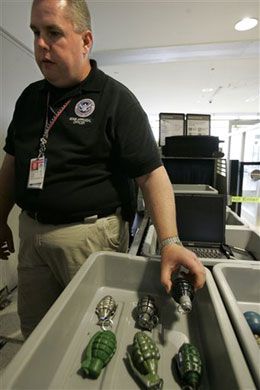Bomb, behavior screeners helping to reduce delays
|
By Victor Epstein
Associated Press
NEWARK — Airport screener Rupesh Persaud still remembers the day he first discovered that the behavior detection training he’d received from the Transportation Security Administration actually works.
The 30-year-old used the physical indicators he’d been taught -- deception and fear tells similar to the those studied by professional poker players -- to identify a suspicious traveler passing through a security checkpoint at Newark Liberty International Airport.
“He was showing signs of fear and he had some stress factors in there too,” said Persaud, who questioned the man after he was pulled aside for a bag search. “When we found the knife, he became irate. It turned out he had a warrant and the police took him away.”
Persaud, of Paterson, is one of 2,000 behavior detection specialists and 240 explosives detection specialists who have been assigned to U.S. airports since 2004.
Their first and foremost goal is catching potential terrorists and stopping dangerous passengers. But their methods have had another upside for travelers -- reducing delays and decreasing passenger stress levels.
“TSA is reclaiming the quality of life for passengers,” said TSA spokeswoman Lara Uselding.
Uselding said reducing the stress levels of air travelers in turn helps behavior specialists spot suspicious ones in a calm crowd.
It seems to be working. Of the 60,285 passengers behavioral screeners deemed suspicious so far this year, 509 were arrested for various reasons, according to the TSA.
The new specialists also have cut the number of terminal evacuations nearly in half this year from 2007 -- there were 98 terminal evacuations nationwide so far this year, compared with 194 in 2007. Each evacuation cost airlines thousands of dollars, delays flights and causes passengers to miss their connections and rides.
Because the specialists are nearby, screeners have someone to quickly turn to at a checkpoint when they’re not sure if a passenger or item is a threat, instead of having to bring in outside experts or proceed alone.
Mike Walsh, who joined TSA as a bomb appraisal officer after 21 years with the New York Police Department bomb squad, said many things can appear suspicious to a vigilant screener, including blocks of cheese that resemble plastic explosives on X-ray machines.
Some of the them are false alarms.
In June, bomb specialists were summoned to a Newark Liberty checkpoint to inspect an art project a student was taking to Europe. The project, which had batteries, wires and switches attached to books, raised red flags but turned out to be benign.
That’s not always the case.
A suspected pipe bomb was found in a carry-on bag at Long Island’s MacArthur Airport last month, and TSA officers in Orlando found dynamite in a man’s luggage in April after a behavior specialist spotted a suspicious passenger.
Because the specialty screeners are there, the TSA has been able to lift some baggage restrictions.
Cigarette lighters, which were banned in 2007 in response to convicted shoe bomber Richard Reid’s failed attempt to light a shoe bomb aboard an American Airlines flight, are now permitted. And breast milk, which was restricted after an intelligence warning about liquid explosives, is also now allowed.
And starting Nov. 20, airports across the country will have designated security lanes for families to move through preflight inspections at their own pace, just in time for the busy U.S. holiday travel season.
But sometimes, a sweaty passenger is just that and nothing more.
When screener Anthony Denarco came across a 7-inch butcher knife in a passenger’s carryon bag, he pulled the man aside for questioning.
“He was also exhibiting some involuntary stress factors,” Denarco said.
The man, an Orthodox Jew, told Denarco he had forgotten the knife was in there.
“He said he was attending his daughter’s wedding and the knife was for religious purposes,” Denarco said.
After being questioned, screeners released the man -- without the knife.
Persaud, a father of two children, said he’s found the behavioral screening techniques he uses at work are also useful in “every day in normal life.”
“It even works with my kids at home,” he said.


